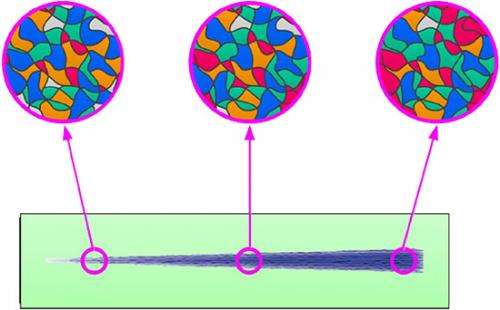Technique to develop low-friction materials with application for energy issues

A research group led by Dr. Masahiro Goto and Dr. Michiko Sasaki created an unprecedented, highly efficient method for developing friction materials with a desired frictional property. The method is able to drastically accelerate the development of materials that have a friction coefficient suited to the purpose of use, such as low-friction materials for reducing energy loss and high-friction materials required for high-performance brakes.
Technology for freely controlling the friction coefficient of a material is a vital factor in the development of new materials. For instance, amid the worsening of the global environment and energy issues, reduction of frictions in generators and motors directly leads to energy conservation. Under such circumstances, technology to control friction force by coating an existing structural material is drawing attention. However, since the frictional property of a coating changes considerably due to differences in the crystal preferred orientation, an enormous number of experiments with varied compositions and crystalline structures and orientations are required in order to obtain a material with a desired frictional property, which has lengthened the development process. This time, the research group applied combinatorial technology to the development of friction materials conducted through control of crystal preferred orientation for the first time, and created a completely new technique that enables highly efficient materials development that only requires one trial experiment, eliminating the need to conduct experiments many times.
For example, zinc oxide (ZnO), which is a general metal oxide, exhibits a low-friction phenomenon when its crystal preferred orientation is optimized. However, to find the optimum crystal preferred orientation and structure for achieving such low-frictional property, it was conventionally necessary to create a large number of samples with varied crystal preferred orientations by changing the coating conditions and evaluate their crystal preferred orientation and frictional property, which required a long R&D period.
In this research, the group led by Dr. Goto analyzed the crystal structure of each microscopic region of the slide mark remaining after sliding a material while changing the conditions of the coating film (load, type of indenter material, number of sliding cycles, etc.), and discovered that it is possible to change the crystal preferred orientation by changing such conditions. In addition, the group made it possible to clarify the correlation between the friction coefficient and the crystal preferred orientation through only one experiment by also measuring the friction coefficient of the location corresponding to the crystal preferred orientation. This technique also enables control of the crystal preferred orientation of a material by a friction process alone by changing the sliding conditions, which is an achievement that significantly expands the potential of friction materials development.
The combinatorial tribological technique proposed by the group, which is able to acquire information on the crystal structure and the crystal preferred orientation required for achieving the desired friction coefficient in a short time, and can change the crystal preferred orientation of the surface layer of a material to a specific orientation by mere friction, is expected to become a leading technique in future friction materials research.
The results of this research has been published in Tribology Letters, Vol.55 (2014) 289-293. The research was carried out under the Grant-in-Aid for Scientific Research (A) (21246030) and as part of a project of the Green Tribology Innovation Network in the area of Advanced Environmental Materials of the Green Network of Excellence (GRENE) program sponsored by the Ministry of Education, Culture, Sports, Science and Technology.
Provided by National Institute for Materials Science



















